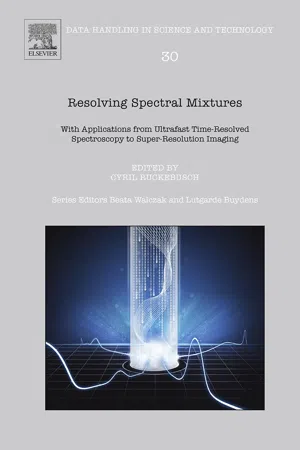
- 674 pages
- English
- ePUB (mobile friendly)
- Available on iOS & Android
About this book
Resolving Spectral Mixtures: With Applications from Ultrafast Time-Resolved Spectroscopy to Superresolution Imaging offers a comprehensive look into the most important models and frameworks essential to resolving the spectral unmixing problem—from multivariate curve resolution and multi-way analysis to Bayesian positive source separation and nonlinear unmixing. Unravelling total spectral data into the contributions from individual unknown components with limited prior information is a complex problem that has attracted continuous interest for almost four decades.Spectral unmixing is a topic of interest in statistics, chemometrics, signal processing, and image analysis. For decades, researchers from these fields were often unaware of the work in other disciplines due to their different scientific and technical backgrounds and interest in different objects or samples. This led to the development of quite different approaches to solving the same problem. This multi-authored book will bridge the gap between disciplines with contributions from a number of well-known and strongly active chemometric and signal processing research groups.Among chemists, multivariate curve resolution methods are preferred to extract information about the nature, amount, and location in time (process) and space (imaging and microscopy) of chemical constituents in complex samples. In signal processing, assumptions are usually around statistical independence of the extracted components. However, the chapters include the complexity of the spectral data to be unmixed as well as dimensionality and size of the data sets. Advanced spectroscopy is the key thread linking the different chapters. Applications cover a large part of the electromagnetic spectrum. Time-resolution ranges from femtosecond to second in process spectroscopy and spatial resolution covers the submicronic to macroscopic scale in hyperspectral imaging.- Demonstrates how and why data analysis, signal processing, and chemometrics are essential to the spectral unmixing problem- Guides the reader through the fundamentals and details of the different methods- Presents extensive plots, graphical representations, and illustrations to help readers understand the features of different techniques and to interpret results- Bridges the gap between disciplines with contributions from a number of well-known and highly active chemometric and signal processing research groups
Frequently asked questions
- Essential is ideal for learners and professionals who enjoy exploring a wide range of subjects. Access the Essential Library with 800,000+ trusted titles and best-sellers across business, personal growth, and the humanities. Includes unlimited reading time and Standard Read Aloud voice.
- Complete: Perfect for advanced learners and researchers needing full, unrestricted access. Unlock 1.4M+ books across hundreds of subjects, including academic and specialized titles. The Complete Plan also includes advanced features like Premium Read Aloud and Research Assistant.
Please note we cannot support devices running on iOS 13 and Android 7 or earlier. Learn more about using the app.
Information
Introduction
1 Corresponding author: email address: [email protected]
Abstract
Keywords
1 Introduction
2 The Spectral Mixture Problem
3 Book Content and Organization
Multivariate Curve Resolution-Alternating Least Squares for Spectroscopic Data
† Institute of Environmental Assessment and Water Research (IDÆA) SPANISH COUNCIL OF SCIENTIFIC RESEARCH (CSIC), Barcelona, Spain
1 Corresponding author: email address: [email protected]
Abstract
Keywords
Table of contents
- Cover image
- Title page
- Table of Contents
- Copyright
- Contributors
- Preface
- Foreword
- Chapter 1: Introduction
- Chapter 2: Multivariate Curve Resolution-Alternating Least Squares for Spectroscopic Data
- Chapter 3: Spectral Unmixing Using the Concept of Pure Variables
- Chapter 4: Ambiguities in Multivariate Curve Resolution
- Chapter 5: On the Analysis and Computation of the Area of Feasible Solutions for Two-, Three-, and Four-Component Systems
- Chapter 6: Linear and Nonlinear Unmixing in Hyperspectral Imaging
- Chapter 7: Independent Components Analysis: Theory and Applications
- Chapter 8: Bayesian Positive Source Separation for Spectral Mixture Analysis
- Chapter 9: Multivariate Curve Resolution of Wavelet Compressed Data
- Chapter 10: Chemometric Resolution of Complex Higher Order Chromatographic Data with Spectral Detection
- Chapter 11: Multivariate Curve Resolution of (Ultra)Fast Photoinduced Process Spectroscopy Data
- Chapter 12: Experimental and Data Analytical Approaches to Automating Multivariate Curve Resolution in the Analysis of Hyperspectral Images
- Chapter 13: Multiresolution Analysis and Chemometrics for Pattern Enhancement and Resolution in Spectral Signals and Images
- Chapter 14: A Smoothness Constraint in Multivariate Curve Resolution-Alternating Least Squares of Spectroscopy Data
- Chapter 15: Super-Resolution in Vibrational Spectroscopy: From Multiple Low-Resolution Images to High-Resolution Images
- Chapter 16: Multivariate Curve Resolution for Magnetic Resonance Image Analysis: Applications in Prostate Cancer Biomarkers Development
- Chapter 17: Endmember Library Approaches to Resolve Spectral Mixing Problems in Remotely Sensed Data: Potential, Challenges, and Applications
- Chapter 18: Spectral–Spatial Unmixing Approaches in Hyperspectral VNIR/SWIR Imaging
- Chapter 19: Sparse-Based Modeling of Hyperspectral Data
- Index